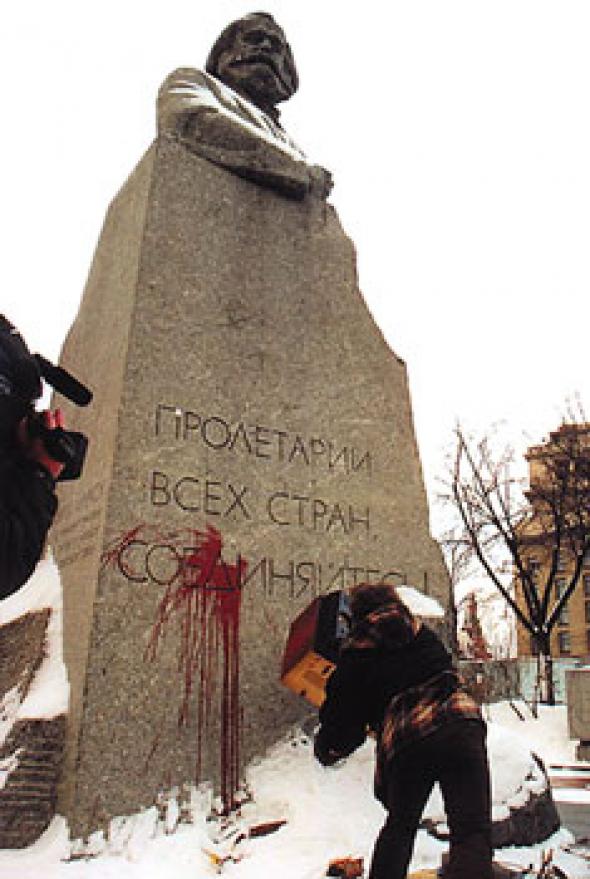Ol' Red Square Eyes
Television is the new assembly zone in which the avatars of Russia’s ruling party are built and refined. Ivan Zassoursky, TV-smasher extraordinaire, lays the plot bare.
During the first Chechen war the media in Russia were mostly anti-war. Their fierce attacks on the president, the government, and the military ruined the war effort. In 1995 Boris Yeltsin’s rating fell as low as 6% — and this less than a year before the elections. But the guy was determined to get reelected anyway, so his ruling party started to rebuild the media system.
The first thing they did was to bring TV under their control. This operation was carried out by Boris Berezovsky, who thus acquired not only an unprecedented ability to mould public opinion but also a very strong position in the media. Russian TV’s first channel, Ostankino, was bankrupted and re-launched as Public Russian Television or ORT, with Berezovsky landing16% of the shares and an informal right to replace management at will. His partner Eduard Sagalaev, the guy who cheated Ted Turner, was appointed as the chairman of Channel 2, state-controlled Russian television, or RTR. The communists were defeated. And television has been tightly controlled ever since.
ORT and RTR are remnants of the centralised Soviet television system; they cover 99 and 97 percent of Russian territory respectively, leagues ahead of the competition. And they have always gathered tons of eyeballs in the provinces, where people are not as media-literate as Muscovites. In the competitive media environment they remain the main instruments of government propaganda — but no longer in the Soviet sense of the word. The technologies of persuasion developed during the 1996 election campaign are much more subtle and powerful than Soviet styles of indoctrination. In the good old days of the USSR communists relied on print, hence their obsession with dogma and rigid language that could deceive no one. The new Russian media system, by contrast, is based on TV; thus it operates with images, arranged according to the logic of political spectacle.
The new technologies of manipulating public opinion developed in 1996 were about writing the scripts of political spectacle and broadcasting the images country-wide. The explosions in Moscow in 1999, whoever did them, were the perfect overture to the war and provided a brilliant new setting for the election campaign. This changed the climate in the country immediately; although Chechens denied they did it, they were blamed. The image of the enemy was thus created. After the Chechens invaded Dagestan, allegedly relying on $ 2 million donated to commander Basaev by Boris Berezovsky ("to build a bakery"), this took the plot even further. The second Chechen war was thus a retaliation, and the scene within which a new character, Vladimir Putin, could be developed; thus started, he was instantly on his way to becoming the war hero and the next president. The scriptwriters made sure he couldn’t lose..
TV - Smashing Factfile:
February 2000: Zassoursky’s group OSVOD, together with Soyus 2000, launch campaign calling for boycotting of both main TV channels and of elections. Slogan: ‘Television vs Internet’. They decide to smash TV sets.
March 9 2000: Group write press release promising TV-smashing and speeches by terrorists in two days’ time, and fax this all over the media.
March 10, 2000: Group purchases two dead TVs for $10 apiece, to be delivered to a spot beside the Marx Monument on Ohotny Ryad.
March 11, 2000: 13:55: Press from six channels arrive, alongside print and online reporters. Journalists outnumber demonstrators.
16:30: TVs arrive. Speakers attempt to speak, but journalists shout them down, demanding that TVs be smashed immediately, as they’re running to deadlines.
16:45: Zassoursky realises he has nothing to smash the TVs with, so lifts them up and smashes them on the Marx Monument itself. Some passing punks help out.
16:50: Police arrest Zassoursky’s co-conspirator Kagarlitsky.
17:15-17:17: Kagarlitsky interrogated in gaol. Police ask him if any damage was done to Marx. He answers no. Police ask him what kind of TVs got destroyed. He tells them a ‘Temp’ and a ‘Rubin’. They tell him he can go.
18:00: ORT news shows nothing of the event, but city TV channels carry item.
March 12, 2000: ORT and other channels give the event prominent coverage. Politicians claim it proves oligarchs are trying to destabilise the country. Zhirinovsky denounces organisers as puppets of rival presidential candidate. Head of Electoral Commission, seizing on picture of punk girl with ‘Against Everyone’ on her jacket, calls for all participants’ arrest as only official electoral campaigns are legal.
March 18, 2000: Second and final action. Four TVs are gathered for smashing and ten news crews turn up. OSVOD decide to peacefully dispose of the sets by throwing them in the nearest dustbin. Group immediately disband.
Ivan Zassoursky <iiz AT cnt.ru>
Mute Books Orders
For Mute Books distribution contact Anagram Books
contact@anagrambooks.com
For online purchases visit anagrambooks.com








